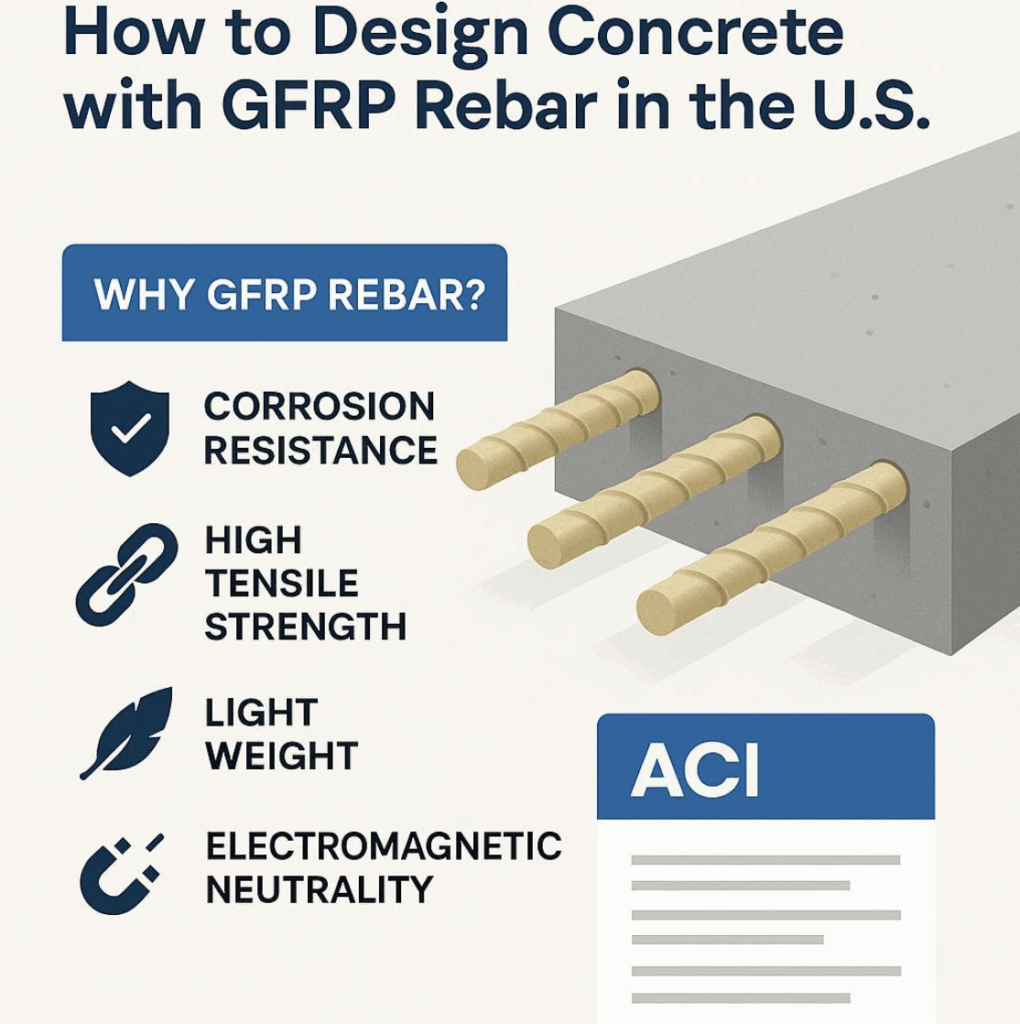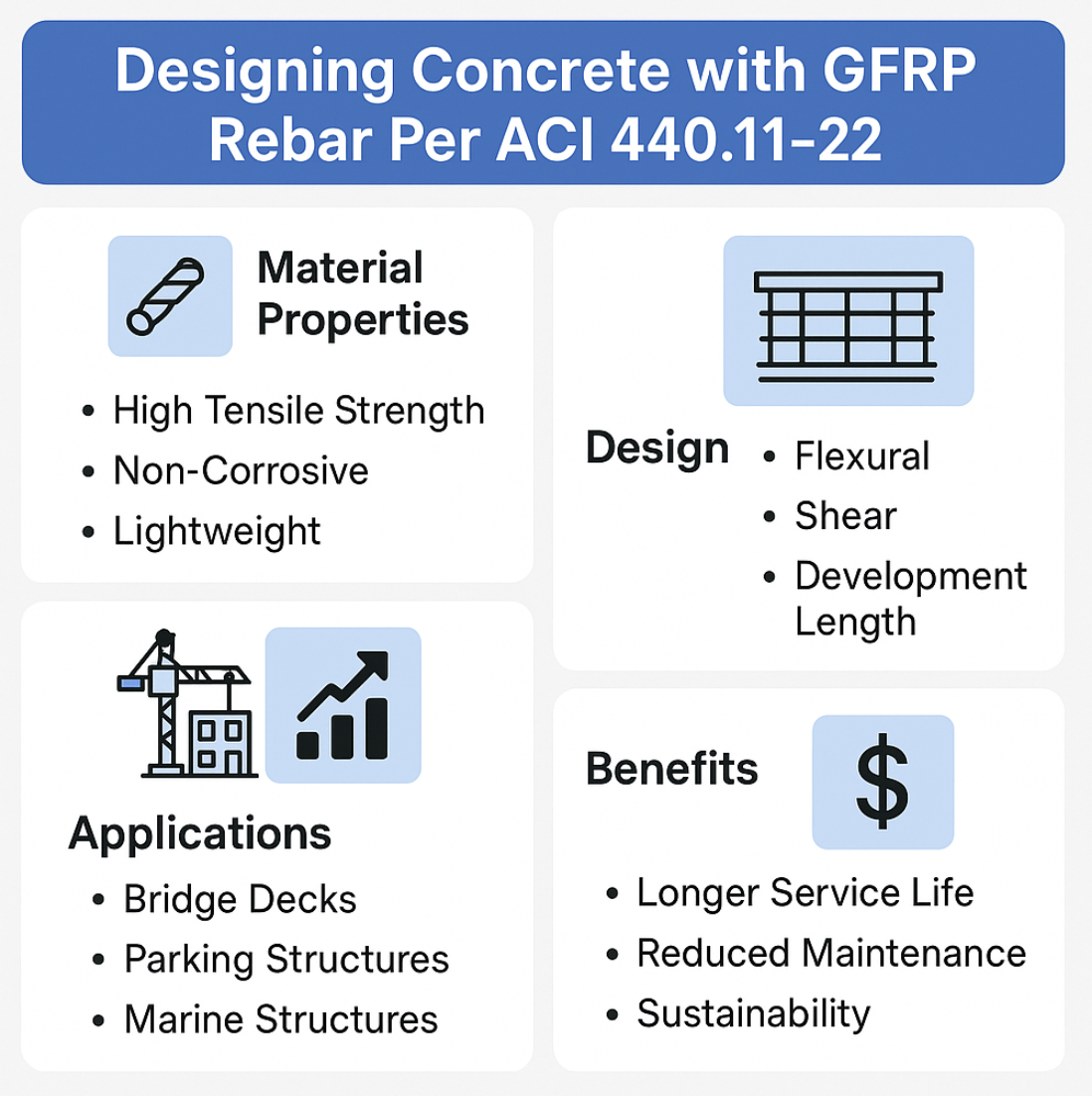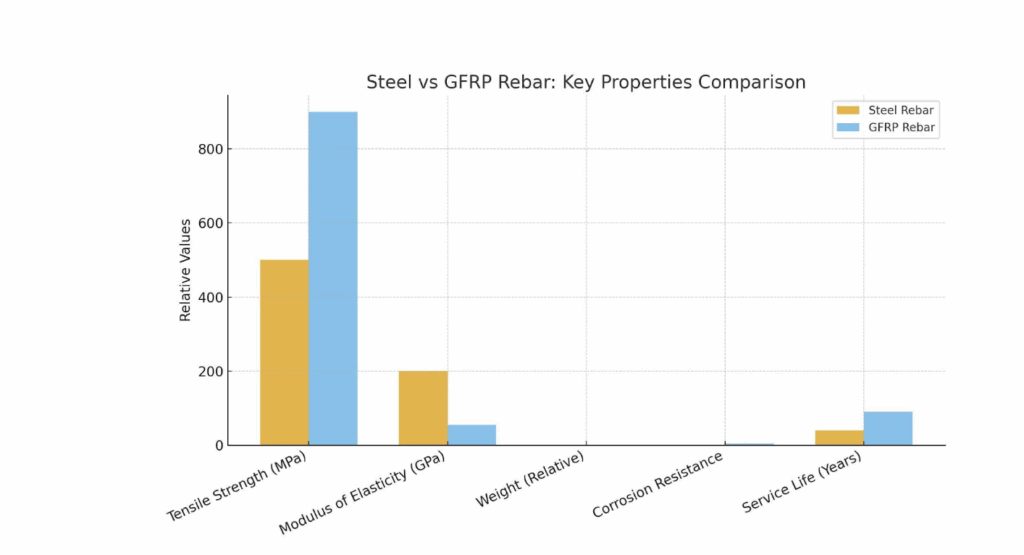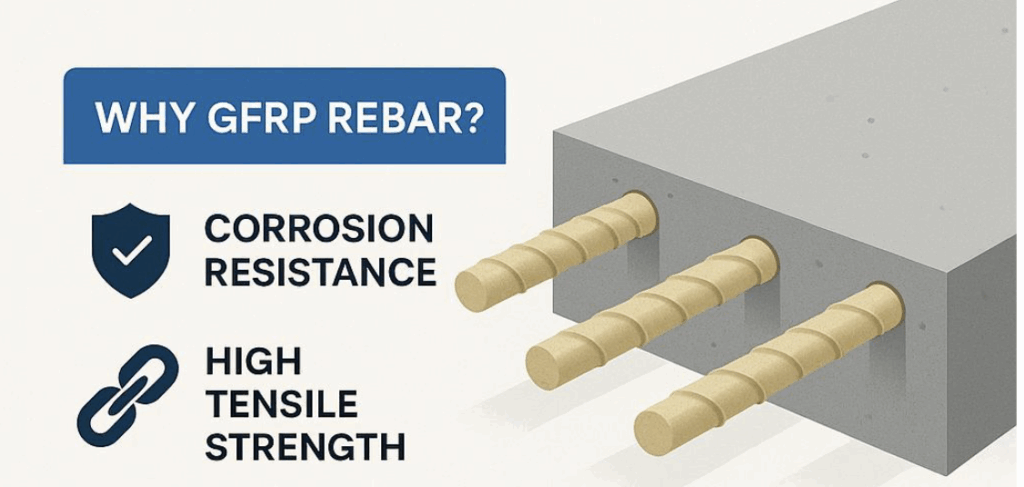En la última década, la industria de la construcción estadounidense se ha enfrentado a enormes desafíos: el envejecimiento de la infraestructura, la corrosión del acero de refuerzo y la necesidad de materiales sostenibles con una vida útil más larga. Las barras de refuerzo de polímero reforzado con fibra de vidrio (PRFV) se han consolidado como una de las alternativas más fiables al acero tradicional.
Sin embargo, el diseño con refuerzo de GFRP en los EE. UU. debe seguir estrictamente las normas establecidas. ACI 440.11-22 – Requisitos del código de construcción para hormigón estructural reforzado con barras de GFRP.
Este artículo explica qué significa ACI 440.11-22 para ingenieros, contratistas y propietarios de proyectos, y cómo diseñar correctamente estructuras de hormigón con barras de GFRP que cumplan con los códigos estadounidenses, los requisitos del DOT y las normas ASTM.
¿Por qué utilizar barras de refuerzo de PRFV?
El refuerzo de acero ha sido la base del hormigón durante más de un siglo, pero presenta un grave problema: la corrosión. Las sales de deshielo, los ambientes marinos y la exposición a la humedad reducen drásticamente su vida útil.
Por el contrario, varilla de refuerzo de fibra de vidrio (GFRP) ofertas:
- Resistencia a la corrosión 100% – No se oxida, ni siquiera en ambientes ricos en cloruros.
- Alta resistencia a la tracción – De 2 a 3 veces más resistente que el acero en relación a su peso.
- Ligero – El 75% es más ligero que el acero, lo que reduce los costes de manipulación y envío.
- neutralidad electromagnética – perfecto para hospitales, laboratorios y centros de datos.
- Sostenibilidad – Se requiere menos recubrimiento de hormigón, menor huella de CO₂, ciclo de vida más largo.

¿Qué es ACI 440.11-22?
ACI 440.11-22 Es el código oficial del Instituto Americano del Concreto que establece cómo diseñar y detallar estructuras de concreto reforzado con barras de GFRP. Garantiza:
- Metodología de diseño uniforme en todo Estados Unidos
- Márgenes de seguridad basados en el comportamiento del material GFRP.
- Aceptación de las barras de refuerzo de GFRP en los códigos de construcción nacionales y estatales.
Normas y códigos relacionados:
- ASTM D7957 – Especificación para barras redondas macizas de PRFV.
- ICC-ES AC454 – Criterios de aceptación para barras de FRP en hormigón.
- IBC 2024 – Incluye referencias al refuerzo de FRP.
- Listas de productos aprobados por el DOT (APL) – Requerido para puentes y proyectos de infraestructura.
Alcance de ACI 440.11-22
ACI 440.11-22 permite el uso de barras de refuerzo de GFRP en:
- Tableros de puentes y estructuras de transporte.
- garajes de estacionamiento con alta exposición a sales de deshielo.
- Estructuras marinas tales como diques y muelles.
- Cimientos, losas y muros en proyectos residenciales y comerciales.
Limitaciones:
- Zonas sísmicas: En las categorías de diseño sísmico altas se aplican algunas restricciones.
- Resistencia al fuego: El PRFV se ablanda a temperaturas extremas, lo que requiere un tratamiento especial.
- Anclaje y curvas: radios mayores en comparación con el acero.
Principios clave de diseño
1. Propiedades del material
- Resistencia a la tracción: típicamente 600–1200 MPa.
- Módulo de elasticidad: ~45–60 GPa (¼ del acero).
- Curva tensión-deformación: Elástico lineal hasta la rotura (sin meseta de fluencia).
2. Diseño de flexión
- Resistencia a la flexión basada en condiciones de fallo equilibradas.
- El aplastamiento del hormigón condiciona el diseño; debe evitarse el fallo por tracción del GFRP.

3. Diseño de corte
- El refuerzo a cortante (estribos) puede ser de GFRP o de acero, según los requisitos del proyecto.
- Las reglas especiales de detallado garantizan la ductilidad.
4. Facilidad de servicio
- Las comprobaciones de deflexión son cruciales debido a la menor rigidez.
- El control del ancho de las grietas requiere barras de mayor diámetro o una separación menor.
5. Longitud de desarrollo y empalme
- Longitudes de empalme por solape son más largas que las del acero.
- Las superficies recubiertas de arena o envueltas helicoidalmente mejoran la adherencia al hormigón.
Construcción y detalles
- Radio de curvatura: típicamente ≥ 10 × diámetro de la barra.
- Corte: Solo con sierras de disco de diamante.
- Colocación: Se recomiendan sillas de plástico o soportes no corrosivos.
- Atadura: Se prefieren las bridas de plástico o de alambre recubierto.
Ejemplo práctico
Imagina diseñar un losa del tablero del puente:
- Utilizando barras de refuerzo de GFRP #3 (3/8 pulg.) espaciadas a 6 pulgadas de centro a centro.
- ACI 440.11 proporciona ecuaciones para verificar la flexión, el corte y la capacidad de servicio.
- En comparación con el acero, se puede reducir el espesor del revestimiento, lo que extiende la vida útil de la cubierta de unos 30 años a más de 75 años.
Comparación: Acero vs. Varillas de refuerzo de PRFV
| Propiedad | varillas de acero corrugado | varillas de refuerzo de PRFV |
| Resistencia a la tracción | 400–600 MPa | 600–1200 MPa |
| Módulo de elasticidad | ~200 GPa | 45–60 GPa |
| Resistencia a la corrosión | Bajo | Excelente (100%) |
| Peso | 1.0 | 0,25 (4 veces más ligero) |
| Vida útil | 30–50 años | 75–100 años |
| Costo por unidad de peso | Más bajo | Ligeramente más alto |
| Costo del ciclo de vida | Más alto (debido a reparaciones) | Inferior (sin mantenimiento) |
Más información:
- Comparación técnica entre varillas de refuerzo de PRFV y varillas de refuerzo de acero
- Varillas de refuerzo de PRFV vs. acero: costo, resistencia y beneficios a largo plazo en la construcción moderna
- Varillas de refuerzo de FRP vs. varillas de refuerzo de acero
Cumplimiento y certificación
Para usar Barras de refuerzo de GFRP en EE. UU. proyectos, los proveedores deben proporcionar:
- Certificados ASTM D7957 para el cumplimiento de los requisitos materiales.
- Informes de evaluación ICC-ES (ER) bajo AC454.
- Aprobaciones del DOT (por ejemplo, FDOT APL, TxDOT, Colorado DOT).
Beneficios para el mercado estadounidense
- Mayor vida útil para las infraestructuras (puentes, carreteras, vías marítimas).
- Presupuestos de mantenimiento reducidos para los municipios.
- Alineación con objetivos de construcción sostenible y programas federales de infraestructura.
Conclusión
La norma ACI 440.11-22 ha consolidado el uso de barras de refuerzo de GFRP en Estados Unidos, brindando confianza a los ingenieros y una ventaja competitiva a los contratistas. Gracias a su resistencia a la corrosión, mayor vida útil y cumplimiento con las normativas estadounidenses, el GFRP no es solo una alternativa, sino el futuro del hormigón armado.
Si usted es un ingeniero, contratista o inversor estadounidense que busca adoptar barras de refuerzo de GFRP en sus proyectos o establecer una planta de producción, Contacte con Composite-Tech Hoy ofrecemos soluciones líderes a nivel mundial. Equipos para la producción de barras y mallas de refuerzo de PRFV, formación completa y apoyo con la certificación.

Preguntas frecuentes
¿Está aprobada la armadura de GFRP por ACI?
Sí, ACI 440.11-22 es el código de diseño oficial para GFRP en los EE. UU.
¿Puedo usar varillas de refuerzo de fibra de vidrio en los cimientos de viviendas?
Sí, la norma ACI 440.11 abarca zapatas, losas y muros. Siempre verifique la conformidad con el código de construcción local.
¿Cuál es la longitud de empalme por solape para GFRP?
Normalmente, diámetros de barra de 40 a 60, dependiendo del tamaño de la barra y del acabado de la superficie.
¿Es resistente al fuego la armadura de fibra de vidrio?
Tiene menor resistencia al fuego que el acero; se necesitan medidas adicionales en ambientes de alta temperatura.
Más información:
- Comprensión de la norma ACI 440.11-22 para fabricantes de barras de refuerzo de GFRP
- Composite-Tech y FRP Institute anuncian una asociación estratégica para redefinir los estándares globales en la industria de refuerzo de FRP
- Preguntas frecuentes sobre equipos Composite-Tech y tecnología GFRP
- Varilla de refuerzo de fibra de vidrio #3 (3/8 pulg.): Precios, peso y casos de uso reales en EE. UU.
- Precio de varillas de refuerzo de PRFV por pie y por kg en EE. UU. (Desglose de costos de 2026)
- Documentación técnica

